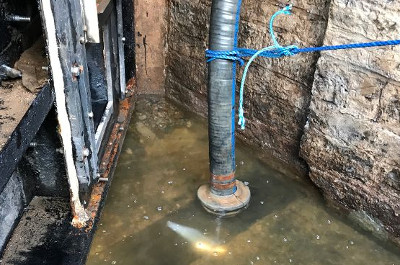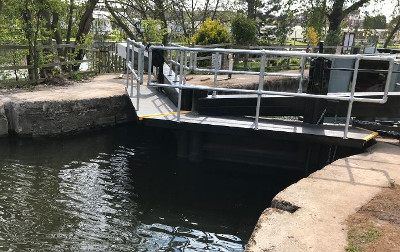AVON Navigation Trust (ANT) engineers uncovered a nasty surprise but also a rich slice of history when they plunged into major work at Evesham Lock.
 The scheduled dewater, repair and upgrade project hit a serious snag when the ANT team’s customary in-depth survey revealed that crumbling stonework behind the 380-year-old lock meant the wall was in danger of collapse.
The scheduled dewater, repair and upgrade project hit a serious snag when the ANT team’s customary in-depth survey revealed that crumbling stonework behind the 380-year-old lock meant the wall was in danger of collapse.
Historic lock structure
However repair work also unveiled the actual historic lock structure, built by Fladbury engineer William Sandys back in the 17th century, with Avon Navigation Trust's Chief Executive Clive Matthews, who led the team, explaining:
“It was a fascinating discovery and, we believe, a first for the Avon. We know that some of the locks, and most of the mills, were built on top of a raft of elm beams, probably taken from sailing ships.
“But Evesham’s is constructed from 'U' sections of beams every ten feet and we only discovered there were uprights when we were trying to work out why the walls had lines of damp.”
 Challenges
Challenges
The discovery, now logged and recorded in the ANT archive, presented its own challenges, as elm, which is stronger than concrete underwater, disintegrates quickly when it dries out.
Once engineers had drained and stanked and lined the lock to stop leak-backs, it was easy to allow water back in to cover the wood overnight and simply drain down again the next day. A dry lock also allows unhindered exploration of any issues and means ANT doesn’t have to call on its onboard diver.
Evesham’s two leaking cills were repaired, the walls re-grouted and the whole lock strengthened and future-proofed with modern engineering solutions.
As always the team ticked off a 15 task-long to-do list, including new handrails and walkways, leaving the lock all well and good for the next 30 or 40 years.
Inovation to stop water jet
ANT is trialling an innovation at Evesham to foil an inherited problem on some of the historic locks. Clive has designed a Top Paddle Deflector to divert the jet of water that shoots out when the paddles are raised. It will be rolled out onto the other two affected locks, at Fladbury and Pershore, after a season’s trial.
The team also added a conduit under the lock to deliver power and water to the Evesham lock islands moorings for the first time, and still managed to reopen the lock well in time to greet the hundreds of new season boaters, with Clive adding:
“It was a very satisfactory project and quite a novelty for me as it was the first year in the decade I’ve been here that we were actually able to follow the plan, rather than dash off to deal with floods."
